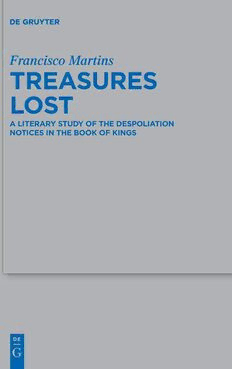Table Of ContentFranciscoMartins
TreasuresLost
Beihefte zur Zeitschrift
für die alttestamentliche
Wissenschaft
Edited by
John Barton, Reinhard G. Kratz, Nathan MacDonald,
Sara Milstein and Markus Witte
Volume 543
Francisco Martins
Treasures Lost
A Literary Study of the Despoliation Notices
in the Book of Kings
ISBN978-3-11-077611-9
e-ISBN(PDF)978-3-11-077889-2
e-ISBN(EPUB)978-3-11-077901-1
ISSN0934-2575
LibraryofCongressControlNumber:2021950584
BibliografischeInformationderDeutschenNationalbibliothek
TheDeutscheNationalbibliothekliststhispublicationintheDeutscheNationalbibliografie;
detailedbibliographicdataareavailableontheInternetathttp://dnb.dnb.de.
©2022WalterdeGruyterGmbH,Berlin/Boston
Typesetting:MetaSystemsPublishing&PrintservicesGmbH,Wustermark
Printingandbinding:CPIbooksGmbH,Leck
www.degruyter.com
Acknowledgements
This monograph is a slightly revised version of my doctoral thesis, which was
completed at the Hebrew University of Jerusalem in 2021. I am deeply grateful
to my supervisor, Prof. Ronnie Goldstein, who encouraged and supported this
projectineverypossibleway.HislovefortheScripturesandhisacademicinteg-
rity are a true inspiration and I cannot thank him enough for his critical com-
mentsandinsightfulremarks,hiswordsofencouragement,andhisunshakable
enthusiasm and tremendous patience. Our ongoing friendship is a happy divi-
dendofmyyearsinJerusalem.SincerethanksarealsoduetoProf.ReinhardG.
Kratz(UniversityofGöttingen),whohostedmetwiceattheTheologicumwhile
Iwasworkingonthethesis:Iwillneverforgetourlongandthought-provoking
discussions on the texts analyzed here and a whole range of scholarly topics.
His perceptive feedback and valuable advice shaped my understanding of the
exegetical task and helped me to produce a clearer and more precise work. I
amalsothankfultoProfessorsMichaelSegal(HebrewUniversityofJerusalem)
and David S.Vanderhooft (Boston College), members of the thesis committee,
whometiculouslyreadandcommentedonpartsofthedissertation,supporting
theprojectfromtheverybeginning.IwouldalsoliketothankProfessorsDom-
inikMarkl(PontificalBiblicalInstitute–Rome)andReinhardMüller(University
ofGöttingen),examinersofthethesis,fortheircareinreading,instructivecom-
ments,andhelpfulsuggestions.
My thanks go to the editors of Beihefte zur Zeitschrift für die alttestament-
licheWissenschaft(BZAW)–ProfessorsJohnBarton,ReinhardG.Kratz,Nathan
MacDonald, Sara Milstein, and Markus Witte – for accepting this monograph
for publication in the BZAW series. Thanks are also due to Dr. Emily Abdeni-
Holman,adearestfriend,whoskillfullyandefficientlyproofreadthetext.Need-
lesstosay,anymistakesorweaknessesthatremainaremyown.ToDr.Sophie
Wagenhofer,AliceMuroz,andSabinaDabrowskiatDeGruyter,aswellasFran-
cieKarstedtandChristianBorchardtatMetasystems(Wustermark),Iamgrate-
ful for their careful work and unblemished professionalism. I completed the
workonthismonographwhiledoingpostdoctoralresearchattheUniversityof
Notre Dame (Indiana, USA), hosted by Prof. Gary A. Anderson, a good friend
andanoutstandingmentor:Ithankhimforcreatingtheconditionsthatallowed
metoprepareandsubmitthemanuscriptandthenrevisetheproofs.
The research presented in this monograph was funded by a very generous
scholarshipgrantedtomebytheFundaçãoparaaCiênciaeaTecnologia(FCT).
I am also indebted to the Gordon Family Fellowship in Graduate Studies (He-
brewUniversity).TheBibleDepartment(attheHebrewUniversity)wasmyaca-
demic home between 2016 and 2021 and I feel very privileged to have studied
https://doi.org/10.1515/9783110778892-201
vi Acknowledgements
inoneoftheforemostinstitutionsinthefieldofBiblicalStudies:myprofessors
andcolleagueswereagentlebutconstantremindertostriveforexcellenceand
toremainfullycommittedtoreadingandstudyingthebiblicaltextswithphilo-
logical rigor and historical perspective. I would also like to extend my thanks
tothefollowinginstitutions,whichprovidedmewiththeresourcestoconduct
myresearch:theBloomfieldLibraryfortheHumanitiesandSocialSciences;the
École biblique et archéologique française de Jérusalem; the Studium Biblicum
Franciscanum;andtheFacultyofTheologyattheUniversityofGöttingen.
AdebtofwholeheartedgratitudeisduetotheSocietyofJesus,thereligious
order to which I belong. When I joined the Jesuits in 2005, I could have never
imagined that I would be granted the privilege of living and studying in so
many different countries and learning so much from this unique international
experience.IamespeciallyindebtedtoFr.NunodaSilvaGonçalves,Fr.Alberto
Brito, and Fr. José Frazão Correia, who encouraged me to study advanced de-
greesinTheologyandBiblicalStudiesandgrantedmefullsupportandallthe
necessary resources. I also thank all the members of the Portuguese Province
oftheSocietyofJesusandtheJesuitswithwhomIlivedinMadrid,Paris,Jeru-
salem,Göttingen,andSouthBend(Indiana,USA).
Finally, I want to thank my family and friends. My father, Cristina, my
brothers,andmysisterweresteadfastsupportthroughouttheseyearsandtheir
love and care is the most precious gift. I am also indebted to so many friends,
who accompanied me throughout my university life, sharing my joys and
hopes,myfearsandanxieties,whilegenerouslyofferingmeadvice,assistance,
orsimplymust-neededrealitychecks.
The book is dedicated to my mother, whom I hope will one day tell me if
sheenjoyedreadingit.MayitallbeadmaioremDeigloriam.
FranciscoMartins
SouthBend(Indiana,USA),April2022
Contents
Acknowledgements v
Abbreviations xiii
1 Introduction 1
1.1 TheObjectofThisStudy 1
1.2 PreviousStudiesontheDespoliationNoticesinKings 2
1.3 TheAngleAdoptedinThisMonograph 4
1.3.1 StudyingaLiteraryMotif 4
1.3.2 ARigorousHistorico-CriticalAnalysis 6
1.3.3 AContextualApproach 9
1.4 TheOutlineofThisStudy 10
2 TheDespoliationNoticesintheBookofKings:Analysis
oftheTexts 11
2.1 1Kings14:25–28 11
2.1.1 TextualIssues 11
2.1.2 Literary-andSource-CriticalAnalysis 16
2.1.3 AnalysisoftheLiteraryMotif 27
2.1.3.1 When/InWhichContextDidtheDespoliationTakePlace? 27
2.1.3.2 Whois/aretheActiveCharacter(s)intheDespoliation? 28
2.1.3.3 WhichGoods/ObjectsareTaken/GivenAway? 28
2.1.3.4 WhatistheTerminologyUsedtoDescribe
theDespoliation? 29
2.1.4 SitzinderLiteratur(Inner-BiblicalAnalysis) 31
2.1.4.1 1Kings14:22–24 31
2.1.4.2 2Samuel8:7 32
2.1.4.3 2Kings24:10–17 36
2.2 1Kings15:17–22 38
2.2.1 TextualIssues 39
2.2.2 Literary-andSource-CriticalAnalysis 42
2.2.3 AnalysisoftheLiteraryMotif 47
2.2.3.1 When/InWhichContextDidtheDespoliationTakePlace? 47
2.2.3.2 Whois/aretheActiveCharacter(s)intheDespoliation? 50
2.2.3.3 WhichGoods/ObjectsareTaken/GivenAway? 52
2.2.3.4 WhatistheTerminologyUsedtoDescribe
theDespoliation? 52
viii Contents
2.2.4 SitzinderLiteratur(Inner-BiblicalAnalysis) 55
2.2.4.1 1Kings15:16 55
2.2.4.2 1Kings15:15 61
2.2.4.3 2Kings16:5–9 62
2.3 2Kings12:18–19 63
2.3.1 Literary-andSource-CriticalAnalysis 64
2.3.2 AnalysisoftheLiteraryMotif 67
2.3.2.1 When/InWhichContextDidtheDespoliationTakePlace? 67
2.3.2.2 Whois/aretheActiveCharacter(s)intheDespoliation? 68
2.3.2.3 WhichGoods/ObjectsareTaken/GivenAway? 69
2.3.2.4 WhatistheTerminologyUsedtoDescribe
theDespoliation? 71
2.3.3 SitzinderLiteratur(Inner-BiblicalAnalysis) 71
2.3.3.1 2Kings12:5–17 71
2.3.3.2 2Samuel8:11–12;1Kings7:51b;1Kings15:15
(andJoshua6:19.24) 75
2.4 2Kings14:8–14 80
2.4.1 TextualIssues 81
2.4.2 Literary-andSource-CriticalAnalysis 83
2.4.3 AnalysisoftheLiteraryMotif 88
2.4.3.1 When/InWhichContextDidtheDespoliationTakePlace? 88
Excursus:Joash’sFableasaWarningandaPrediction 92
2.4.3.2 Whois/aretheActiveCharacter(s)intheDespoliation? 96
2.4.3.3 WhichGoods/ObjectsareTaken/GivenAway? 96
2.4.3.4 WhatistheTerminologyUsedtoDescribethe
Despoliation? 97
2.4.4 SitzinderLiteratur(Inner-BiblicalAnalysis) 98
2.4.4.1 2Kings14:7 98
2.4.4.2 2Kings24:20–25:21 102
2.5 2Kings16:5–9 110
2.5.1 TextualIssues 110
2.5.2 Literary-andSource-CriticalAnalysis 113
HistoricalExcursus:WhatDoWeKnowAbouttheSyro-Ephraimite
War? 119
2.5.3 AnalysisoftheLiteraryMotif 123
2.5.3.1 When/InWhichContextDidtheDespoliationTakePlace? 123
2.5.3.2 Whois/aretheActiveCharacter(s)intheDespoliation? 125
2.5.3.3 WhichGoods/ObjectsareTaken/GivenAway? 126
2.5.3.4 WhatistheTerminologyUsedtoDescribe
theDespoliation? 126
Contents ix
Excursus:2Kings16:5.7–9intheLightoftheAssyrianImperial
Ideology 128
2.5.4 SitzinderLiteratur(Inner-BiblicalAnalysis) 131
2.5.4.1 2Kings16:6 131
2.5.4.2 2Kings15 132
2.5.4.3 2Kings15:37 138
2.5.4.4 2Kings16:10–18 142
2.6 2Kings18:13–16 148
2.6.1 TextualIssues 148
2.6.2 Literary-andSource-CriticalAnalysis 153
Excursus:2Kings18:13–15;19:36aβandtheAssyrianAnnals:
ConvergenceandDifference 165
2.6.3 AnalysisoftheLiteraryMotif 173
2.6.3.1 When/InWhichContextDidtheDespoliationTakePlace? 173
2.6.3.2 Whois/aretheActiveCharacter(s)intheDespoliation? 174
2.6.3.3 WhichGoods/ObjectsareTaken/GivenAway? 175
2.6.3.4 WhatistheTerminologyUsedtoDescribe
theDespoliation? 176
2.6.4 SitzinderLiteratur(Inner-BiblicalAnalysis) 177
2.6.4.1 2Kings18:1–12 177
2.6.4.2 2Kings18:17–19:37 180
2.6.4.3 2Kings16:5.7–9(and1Kings15:17–22) 183
2.7 2Kings24:10–17 185
2.7.1 TextualIssues 186
2.7.2 Literary-andSource-CriticalAnalysis 192
2.7.3 AnalysisoftheLiteraryMotif 203
2.7.3.1 When/InWhichContextDidtheDespoliationTakePlace? 203
2.7.3.2 Whois/aretheActiveCharacter(s)intheDespoliation? 204
2.7.3.3 WhichGoods/ObjectsareTaken/GivenAway? 204
2.7.3.4 WhatistheTerminologyUsedtoDescribe
theDespoliation? 205
2.7.4 SitzinderLiteratur(Inner-BiblicalAnalysis) 205
2.7.4.1 2Kings24–25 205
2.7.4.2 1Kings7:48–50 210
2.8 2Kings25:8–21 215
2.8.1 TextualIssues 216
2.8.2 Literary-andSource-CriticalAnalysis 222
2.8.3 AnalysisoftheLiteraryMotif 234
2.8.3.1 When/InWhichContextDidtheDespoliationTakePlace? 234
2.8.3.2 Whois/aretheActiveCharacter(s)intheDespoliation? 235
x Contents
2.8.3.3 WhichGoods/ObjectsareTaken/GivenAway? 238
2.8.3.4 WhatistheTerminologyUsedtoDescribe
theDespoliation? 239
2.8.4 SitzinderLiteratur(Inner-BiblicalAnalysis) 240
2.8.4.1 1Kings7:15–47 240
2.8.4.2 2Kings12:14(and1Kings8:4) 242
3 TheDespoliationNoticesintheBookofKings:Historico-Redactional
Conclusions 247
3.1 NegotiatingImperialPower:Asa,Ahaz,andHezekiahin“theBook
oftheChroniclesoftheKingsofJudah” 247
3.1.1 LiteraryandIdeologicalConvergence:ASynthesis 247
3.1.2 ACompositionalHypothesis:(Re-)tellingthePastinaChronistic
Source 248
3.1.3 ‘HappilyPayingforthePaxImperii’:TheSocialFunctionofThese
Narratives 253
3.1.4 SitzinderLiteratur:ThePlaceandFunctionoftheNarratives
intheDtrHistory 256
3.2 TellingtheEndandAnticipatingIt:2Kings25and2Kings14
intheBookofKings 260
3.2.1 2Kings25:13–17*:MakingSenseofanEnding 260
3.2.2 2Kings25:14–15*:ExtendingContinuityBeyondtheLand 263
3.2.3 2Kings14:8–14:AnticipatingtheEnd(andBlaming
theKing!) 266
3.3 CreatingaHistoryofDecline:TheCumulativeEffect 270
3.3.1 BetweenShushaqandNebuchadnezzar:Spottinga(Possible)
RedactionalLayer 270
3.3.2 ConveyingaSenseofEntropy:TheContribution
oftheDespoliationNotices 272
3.3.3 TheHistorico-IdeologicalHorizon:ExploringaCluein2Kings
24:13–14 276
3.4 Summary 280
4 TheMotifoftheDespoliationoftheTreasuresintheBookofKings
andBeyond:A“Biography” 283
4.1 TheMotifoftheDespoliationoftheTreasuresintheBook
ofKings 283
4.1.1 ‘EnemyattheGates…OrAlreadyInsideThem!’:TheContext
oftheDespoliation 283
4.1.2 TheGivingandTakingoftheTreasures:TheProtagonists
oftheDespoliation 285

